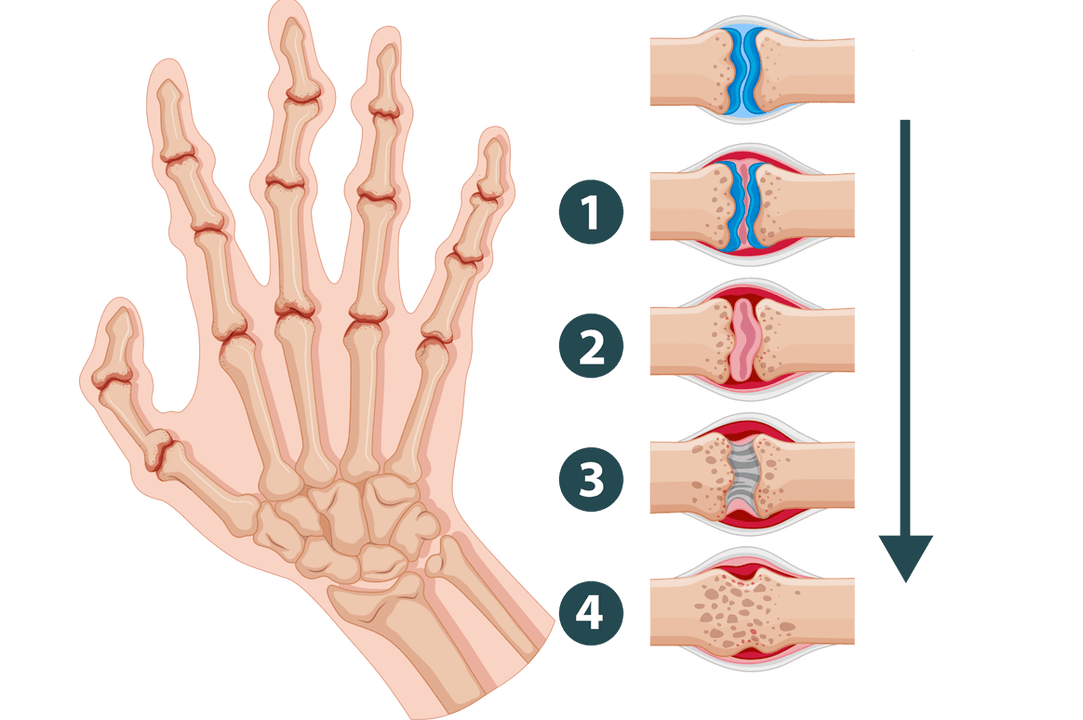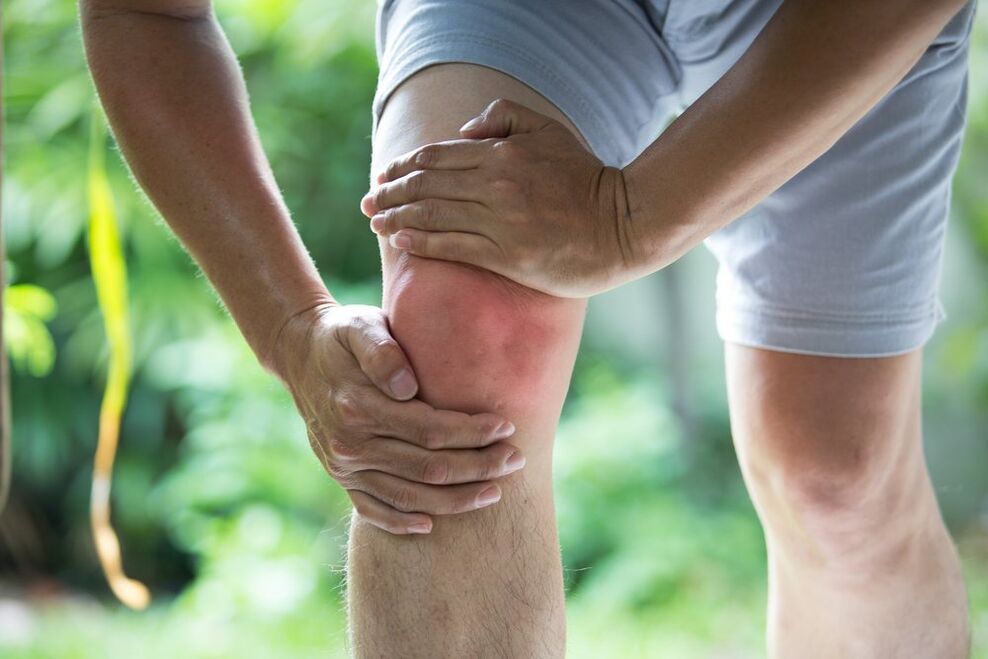The problem of arthritis is always relevant. After forty years, about a third of all people begin to experience pain when moving, and after fifty, more than half of the population begins to experience pain. The gradual destruction of cartilage, ligaments, bones and soft tissue around the joint is called by doctors the general term "osteoarthritis".
How can this situation be prevented? And what treatment will help relieve the pain when the disease has progressed? To answer these questions, you first need to understand the difference between arthritis and arthrosis - the most common joint pathology.
What is arthritis?

What is the main difference between arthritis and arthrosis can be seen from the name: acute disease, suddenly ending with "-itis"; with "-from" - a disease with a slow course, a chronic process.
Arthritis is an inflammatory joint lesion that occurs as a result of damage to the immune system due to infection (for example, sore throat or otitis media), trauma, metabolic disorders, hypothermia, stress or other causes (even autoimmune).
The first signs look like this:
- sharp pain in one or more joints (often not only during movement), especially in the early morning;
- enlargement, swelling, edema, redness of painful joints;
- a significant increase in temperature at the site of inflammation.
The inflammatory process caused by arthritis can affect the entire body. In this case, the patient feels high temperature, chills, loses strength, and may experience inflammation of other organs (eyes, genitourinary system, even heart, lungs, liver and kidneys).
Arthritis has several dozen forms. The most common of them are:
- joint pain– inflammation of the connective tissue of large and medium joints that occurs after infection;
- rheumatoid arthritis– a slow autoimmune process that has a symmetrical effect on several joints at once; causes the appearance of "nodules", pain, loss of mobility; can cause inflammation of many organs;
- gout– caused by the accumulation of uric acid in the blood and salt in the joints; often begins with a sharp pain in the joint of the big toe;
- reactive arthritis– occurs against the background of damage to the body by infection (chlamydia, streptococcus, etc. );
- infectious arthritis– started as a result of bacterial infection in the joint itself.
What is arthrosis?
Unlike arthritis, arthrosis is not accompanied by an inflammatory process. It causes poor circulation in the joints, which causes the cartilage to dry out.
Arthritis is a disease that changes the shape and destroys joint tissue. Thus, the connective layer dehydrates, becomes thinner and "wears out". The bones begin to touch each other, which causes pain and makes it difficult for a person to move.
Signs of joint arthrosis are:
- after a long period of immobility (for example, a night's rest), the joint "freezes", but then develops rapidly when activity is resumed;
- the operation of the joint is accompanied by strange sounds (clicking, creaking, grinding);
- physical activity causes pain.
What is the difference between arthritis and arthrosis?
Both of these diseases affect the joints. But they are caused by different reasons, proceed differently and can lead to very different consequences. Only the correct diagnosis, based on the difference between arthritis and arthrosis, can prevent irreparable harm to the body.
It takes time for cartilage degeneration to develop sufficiently and bone deformation to begin. Therefore, chronic arthrosis usually manifests itself in old age (after 60 years, less often after 50 years). The most vulnerable to changes are the joints that are constantly working under load: musicians' fingers, athletes' and loaders' knees, ankles of people who walk a lot or work while standing, etc.
On the other hand, arthritis can occur even in children. The inflammatory process causes pathology of the synovial membrane, saturated with blood vessels, and joint fluid (while with arthrosis it is only produced in insufficient quantities). Unfortunately, almost every fifth case of disability in the world is caused by various forms and complications of arthritis.
Inflammation can affect not only joints, but also other tissues with active blood circulation: blood vessels and heart, lungs, abdominal organs, eyes, urinary system, etc. On the other hand, arthrosis is limited by local mechanical damage to the bone and the formation of osteophytes in the area of joint deformation. Even in the final stage and advanced form, this disease can also cause disability, completely paralyzing a person's limbs.
How does arthritis and arthrosis manifest?

Let's compare the external manifestations to clearly explain the difference between the symptoms of arthritis and arthrosis.
- ill. In the early stages of arthrosis (which lasts for years), joint pain occurs during physical activity and disappears after rest. It is rarely sharp and strong. Although the disease progresses, when pain can appear even with small movements and even at rest, it is usually enough to give the body a comfortable position for the pain to decrease. With arthritis, the patient is disturbed by sharp attacks of pain with great strength, which can only be extinguished by special medicines. A characteristic symptom is pain at rest, especially in the early morning.
- Clicking, grinding, crushing joints. In joints affected by arthrosis, the cartilage layer is destroyed. They stop protecting the bone heads from touching each other. Therefore, when moving, the bones touch and rub, producing a rough and dry sound. The more the disease progresses, the louder and louder the joint sounds. Arthritis is usually not accompanied by such symptoms.
- Deformation of joints and surrounding tissues. Developing arthrosis over time causes changes in the shape of the bones: their heads begin to collapse and wear, and osteophytes may appear. Sometimes in the acute stage there is swelling and painful pain, but these symptoms do not last. But joints affected by arthritis become inflamed and swollen. Swelling and compaction occur. The skin becomes red and hot.
- Limited mobility. Osteoarthritis causes stiffness in certain joints that disappears with movement. At deeper levels, stiffness increases, flexion amplitude decreases, eventually leading to immobility. With arthritis, you may feel stiffness throughout your body, and attempts to move will cause sharp pain.
- Changes in blood composition. Arthrosis is not an inflammatory disease, so it is not shown in the analysis. Arthritis causes a significant increase in the erythrocyte sedimentation rate, which indicates an active infectious and inflammatory process.
Therefore, symptoms of arthrosis in the early stages can rarely cause severe anxiety and discomfort. This leads to carelessness and late diagnosis of the disease, which means it complicates further treatment.
Causes of osteoarthritis
There are several factors that increase the risk of pathological changes in the joints and surrounding tissues: constant load, imbalance of the immune system and hormones, poor physical shape. Therefore, to avoid disease, you should always follow the following recommendations:
- Maintain moderate physical activity through simple exercise, walking, swimming, etc. This will help you get rid of excess weight, improve blood circulation, strengthen muscles - and thus relieve stress on your joints.
- Try to eat healthy food. Fatty foods, red meat, and alcohol can be harmful. On the other hand, seafood, fruits and vegetables, and dishes containing cartilage and gelatin will be beneficial for the body. It is important to drink plenty of clean water (2-3 liters a day).
- Choose the right clothes and shoes: comfortable heels, warm enough, not restricting movement.
- If possible, avoid stress, distraction and other "shocks" to the body.
However, if a person has been diagnosed with arthritis or arthrosis, before performing such simple actions, you should consult a doctor. In some cases, conventional prevention can also cause harm and worsen the condition.
But how is arthritis and arthrosis treated? What is the difference? The causes of this pathology are different: the immune process, fighting infection in the first case versus cartilage malnutrition in the second. Therefore, the way to deal with them will be different. To choose the right course of action, you must first make an accurate diagnosis.
To do this, it is best to undergo radiography and MRI in combination with laboratory blood and urine tests. After reviewing the results, the doctor will prescribe the appropriate recommendations.
Treatment of arthritis
If the acute form of the disease is caused by an infection, then it can be cured with antibiotics. But in this case, it is important to choose the right medicine: it is necessary to neutralize the pathogenic bacteria before the joint pathology becomes irreversible. This course is supplemented with anti-inflammatory and immune-supporting drugs.
In the case of chronic arthritis (for example, rheumatoid), treatment must be carried out regularly throughout life. The most commonly used are corticosteroids, cytostatics and modern biological products. This is a relatively strong drug, so to ensure that it does not cause harm to the body, calculating the correct dosage, frequency and duration of use is critical.
For severe pain, your doctor may also prescribe a course of analgesics. And accompanying support methods are definitely recommended: diet, physical therapy, and physical therapy courses. If the inflammation has spread to other organs, the patient must be referred for additional specialized examinations.
Treatment of arthrosis
Modern methods make it possible to almost completely eliminate the manifestations of the disease if the diagnosis is made at an early stage and the patient's age does not reach forty years. To do this, in addition to the standard monitoring of pressure on the joints and a course of medication (they start the regeneration, restore nutrition and hydration of the cartilage), the patient may be given mud wraps, electrophoresis and acoustic therapy (which affects the affected tissue with soundlow frequency).
In older people or in an advanced form, arthrosis cannot be completely cured, although it is possible to achieve a significant improvement in the condition and slow down the destructive process in the joints. This requires strict adherence to the doctor's recommendations: regular use of drugs (for example, chondroprotectors), maintaining a healthy lifestyle, completing the prescribed procedures on time, monitoring the load on the joints.
In arthrosis, the main attention is paid to the restoration of the cartilage layer. If there are symptoms of a concomitant inflammatory process, antibiotics or corticosteroids may be prescribed to relieve the acute stage and switch to the main treatment regimen. In some severe cases, surgery and even implantation of an artificial joint may be necessary.
























